Essay on Middle East Conflict: Security Concerns After 1900s
VerifiedAdded on 2022/08/14
|12
|2774
|16
Essay
AI Summary
This essay delves into the historical context of security concerns in the Middle East, focusing on conflicts that have shaped the region since the 20th century. It examines the Israel-Palestine conflict, highlighting the role of religion and the dispute over Jerusalem. The essay also analyzes the Iran-Iraq war, emphasizing the significance of oil resources and the struggle for regional dominance. Furthermore, it explores the impact of superpower involvement, specifically the United States and the Soviet Union, on the region's security dynamics. The essay concludes by underscoring the ongoing challenges, including terrorism and the influence of powerful nations, which continue to threaten peace and stability in the Middle East. This analysis provides a comprehensive overview of the historical issues that have created tensions in the region.
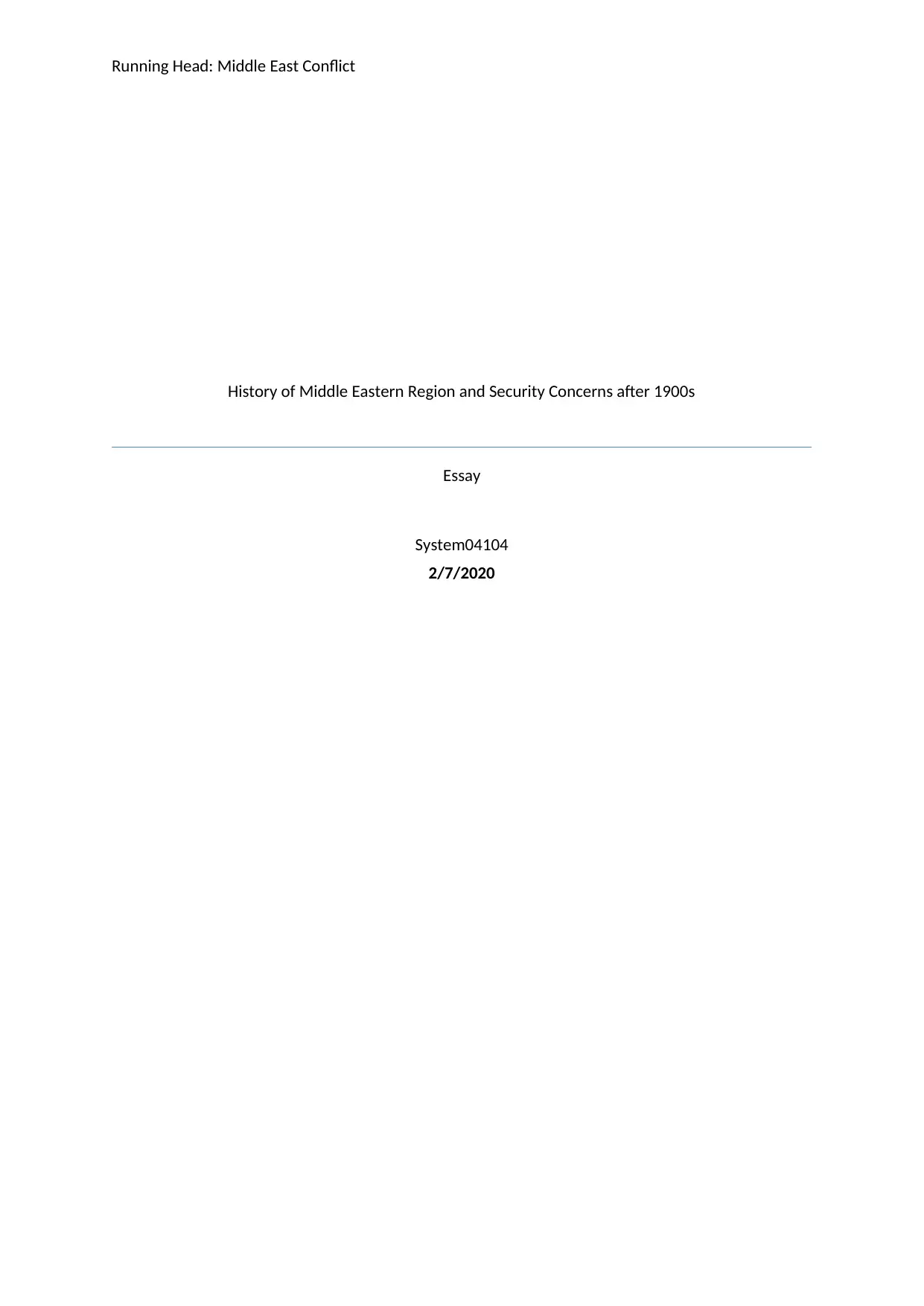
Running Head: Middle East Conflict
History of Middle Eastern Region and Security Concerns after 1900s
Essay
System04104
2/7/2020
History of Middle Eastern Region and Security Concerns after 1900s
Essay
System04104
2/7/2020
Paraphrase This Document
Need a fresh take? Get an instant paraphrase of this document with our AI Paraphraser
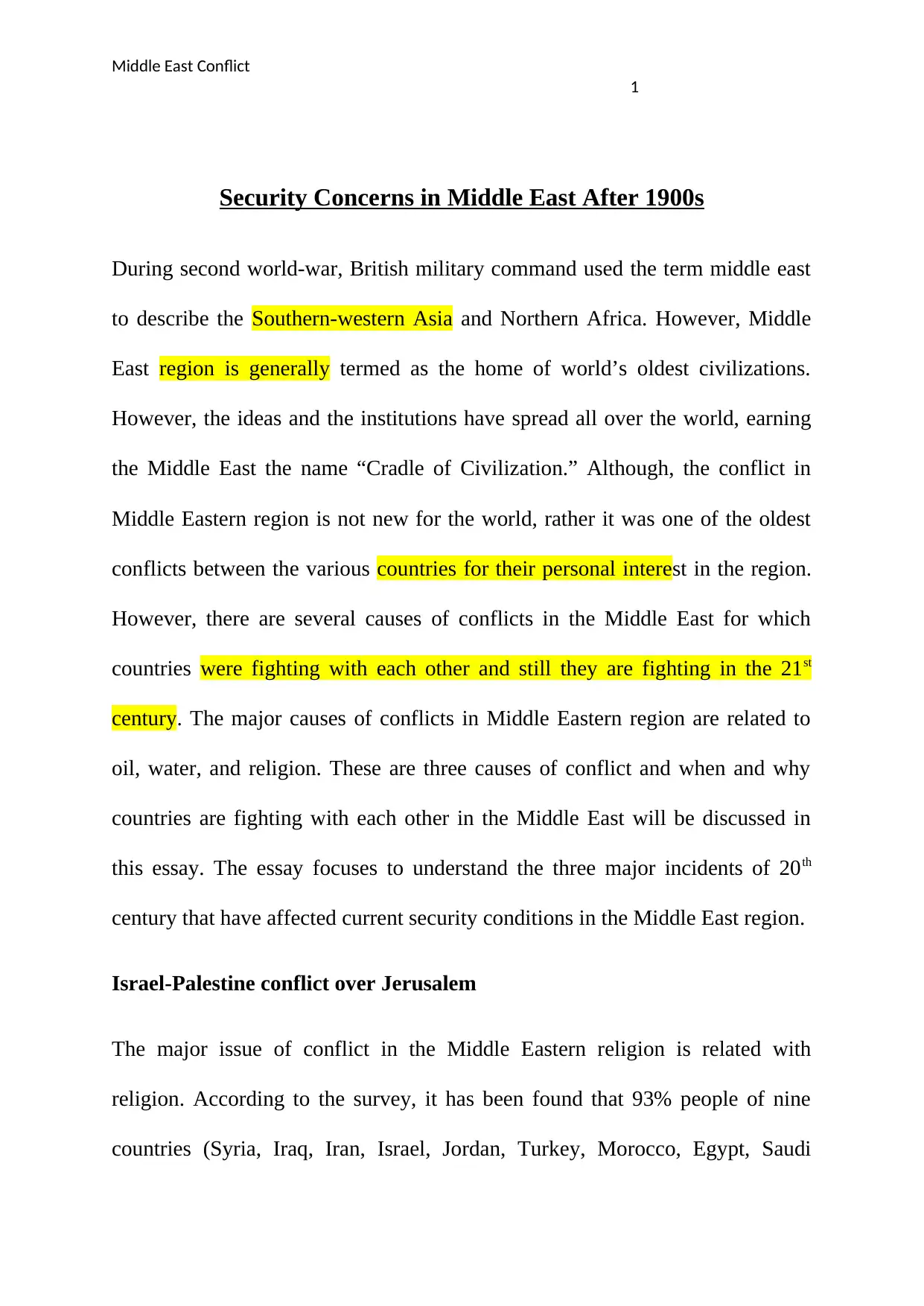
Middle East Conflict
1
Security Concerns in Middle East After 1900s
During second world-war, British military command used the term middle east
to describe the Southern-western Asia and Northern Africa. However, Middle
East region is generally termed as the home of world’s oldest civilizations.
However, the ideas and the institutions have spread all over the world, earning
the Middle East the name “Cradle of Civilization.” Although, the conflict in
Middle Eastern region is not new for the world, rather it was one of the oldest
conflicts between the various countries for their personal interest in the region.
However, there are several causes of conflicts in the Middle East for which
countries were fighting with each other and still they are fighting in the 21st
century. The major causes of conflicts in Middle Eastern region are related to
oil, water, and religion. These are three causes of conflict and when and why
countries are fighting with each other in the Middle East will be discussed in
this essay. The essay focuses to understand the three major incidents of 20th
century that have affected current security conditions in the Middle East region.
Israel-Palestine conflict over Jerusalem
The major issue of conflict in the Middle Eastern religion is related with
religion. According to the survey, it has been found that 93% people of nine
countries (Syria, Iraq, Iran, Israel, Jordan, Turkey, Morocco, Egypt, Saudi
1
Security Concerns in Middle East After 1900s
During second world-war, British military command used the term middle east
to describe the Southern-western Asia and Northern Africa. However, Middle
East region is generally termed as the home of world’s oldest civilizations.
However, the ideas and the institutions have spread all over the world, earning
the Middle East the name “Cradle of Civilization.” Although, the conflict in
Middle Eastern region is not new for the world, rather it was one of the oldest
conflicts between the various countries for their personal interest in the region.
However, there are several causes of conflicts in the Middle East for which
countries were fighting with each other and still they are fighting in the 21st
century. The major causes of conflicts in Middle Eastern region are related to
oil, water, and religion. These are three causes of conflict and when and why
countries are fighting with each other in the Middle East will be discussed in
this essay. The essay focuses to understand the three major incidents of 20th
century that have affected current security conditions in the Middle East region.
Israel-Palestine conflict over Jerusalem
The major issue of conflict in the Middle Eastern religion is related with
religion. According to the survey, it has been found that 93% people of nine
countries (Syria, Iraq, Iran, Israel, Jordan, Turkey, Morocco, Egypt, Saudi
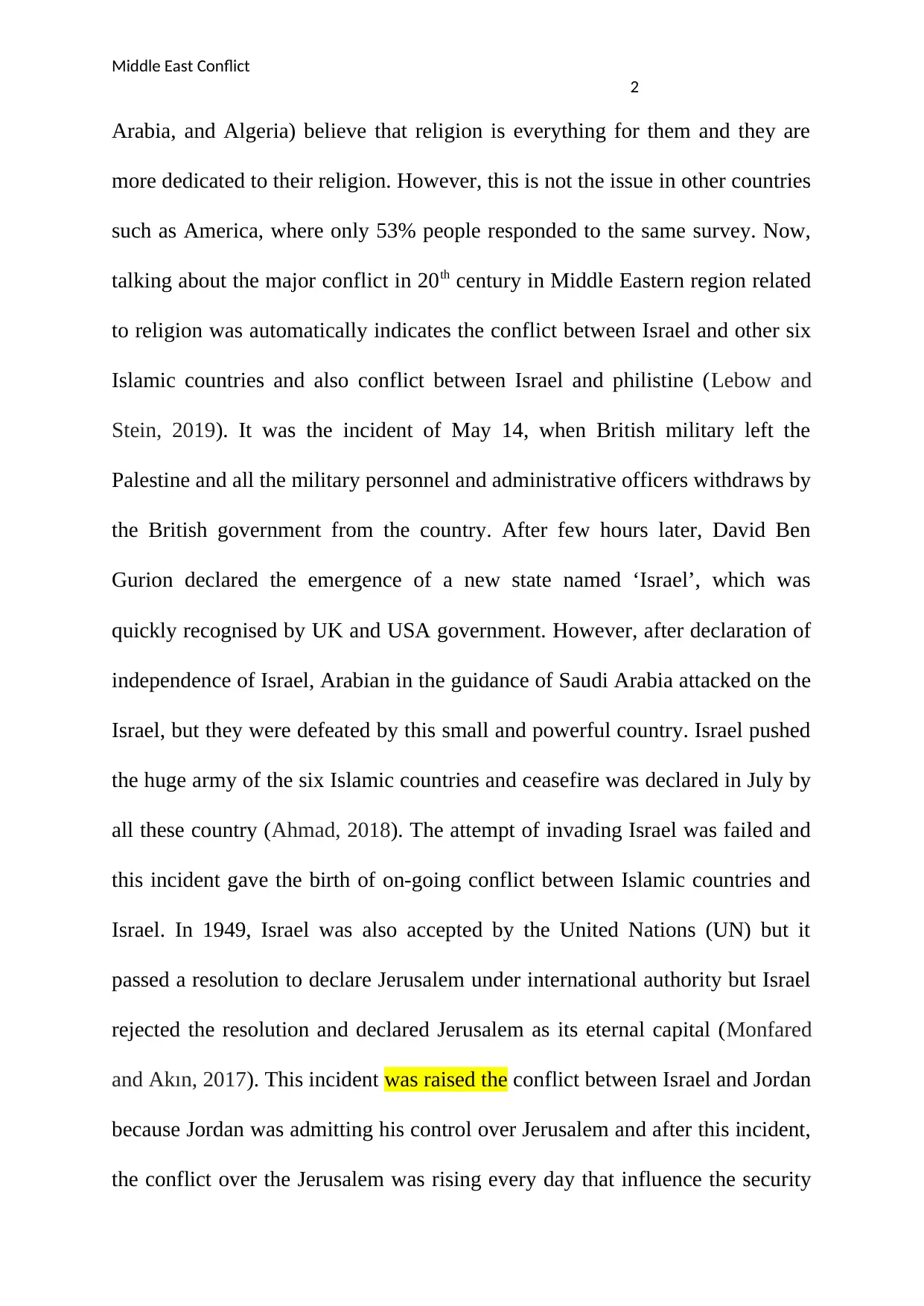
Middle East Conflict
2
Arabia, and Algeria) believe that religion is everything for them and they are
more dedicated to their religion. However, this is not the issue in other countries
such as America, where only 53% people responded to the same survey. Now,
talking about the major conflict in 20th century in Middle Eastern region related
to religion was automatically indicates the conflict between Israel and other six
Islamic countries and also conflict between Israel and philistine (Lebow and
Stein, 2019). It was the incident of May 14, when British military left the
Palestine and all the military personnel and administrative officers withdraws by
the British government from the country. After few hours later, David Ben
Gurion declared the emergence of a new state named ‘Israel’, which was
quickly recognised by UK and USA government. However, after declaration of
independence of Israel, Arabian in the guidance of Saudi Arabia attacked on the
Israel, but they were defeated by this small and powerful country. Israel pushed
the huge army of the six Islamic countries and ceasefire was declared in July by
all these country (Ahmad, 2018). The attempt of invading Israel was failed and
this incident gave the birth of on-going conflict between Islamic countries and
Israel. In 1949, Israel was also accepted by the United Nations (UN) but it
passed a resolution to declare Jerusalem under international authority but Israel
rejected the resolution and declared Jerusalem as its eternal capital (Monfared
and Akın, 2017). This incident was raised the conflict between Israel and Jordan
because Jordan was admitting his control over Jerusalem and after this incident,
the conflict over the Jerusalem was rising every day that influence the security
2
Arabia, and Algeria) believe that religion is everything for them and they are
more dedicated to their religion. However, this is not the issue in other countries
such as America, where only 53% people responded to the same survey. Now,
talking about the major conflict in 20th century in Middle Eastern region related
to religion was automatically indicates the conflict between Israel and other six
Islamic countries and also conflict between Israel and philistine (Lebow and
Stein, 2019). It was the incident of May 14, when British military left the
Palestine and all the military personnel and administrative officers withdraws by
the British government from the country. After few hours later, David Ben
Gurion declared the emergence of a new state named ‘Israel’, which was
quickly recognised by UK and USA government. However, after declaration of
independence of Israel, Arabian in the guidance of Saudi Arabia attacked on the
Israel, but they were defeated by this small and powerful country. Israel pushed
the huge army of the six Islamic countries and ceasefire was declared in July by
all these country (Ahmad, 2018). The attempt of invading Israel was failed and
this incident gave the birth of on-going conflict between Islamic countries and
Israel. In 1949, Israel was also accepted by the United Nations (UN) but it
passed a resolution to declare Jerusalem under international authority but Israel
rejected the resolution and declared Jerusalem as its eternal capital (Monfared
and Akın, 2017). This incident was raised the conflict between Israel and Jordan
because Jordan was admitting his control over Jerusalem and after this incident,
the conflict over the Jerusalem was rising every day that influence the security
⊘ This is a preview!⊘
Do you want full access?
Subscribe today to unlock all pages.

Trusted by 1+ million students worldwide
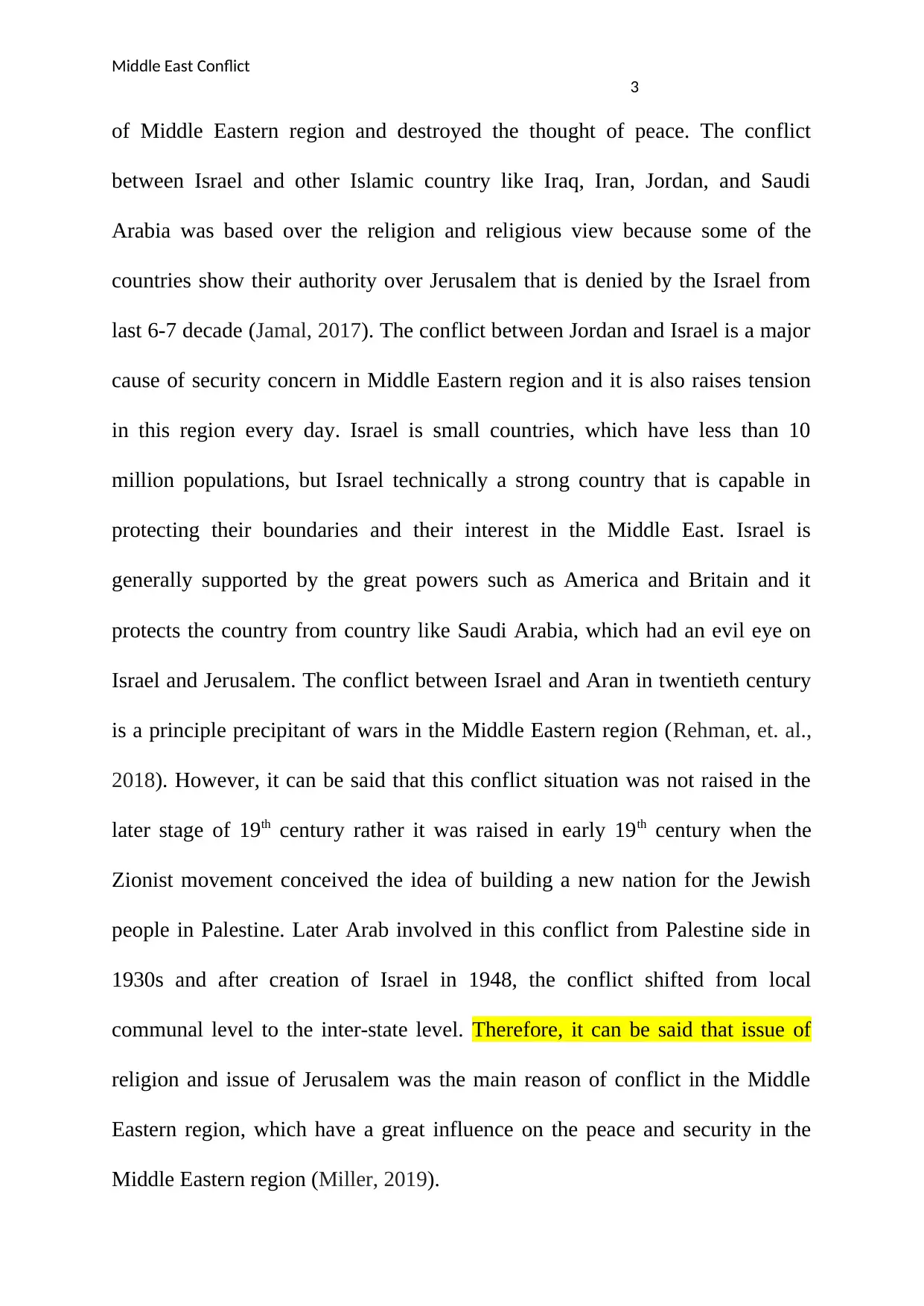
Middle East Conflict
3
of Middle Eastern region and destroyed the thought of peace. The conflict
between Israel and other Islamic country like Iraq, Iran, Jordan, and Saudi
Arabia was based over the religion and religious view because some of the
countries show their authority over Jerusalem that is denied by the Israel from
last 6-7 decade (Jamal, 2017). The conflict between Jordan and Israel is a major
cause of security concern in Middle Eastern region and it is also raises tension
in this region every day. Israel is small countries, which have less than 10
million populations, but Israel technically a strong country that is capable in
protecting their boundaries and their interest in the Middle East. Israel is
generally supported by the great powers such as America and Britain and it
protects the country from country like Saudi Arabia, which had an evil eye on
Israel and Jerusalem. The conflict between Israel and Aran in twentieth century
is a principle precipitant of wars in the Middle Eastern region (Rehman, et. al.,
2018). However, it can be said that this conflict situation was not raised in the
later stage of 19th century rather it was raised in early 19th century when the
Zionist movement conceived the idea of building a new nation for the Jewish
people in Palestine. Later Arab involved in this conflict from Palestine side in
1930s and after creation of Israel in 1948, the conflict shifted from local
communal level to the inter-state level. Therefore, it can be said that issue of
religion and issue of Jerusalem was the main reason of conflict in the Middle
Eastern region, which have a great influence on the peace and security in the
Middle Eastern region (Miller, 2019).
3
of Middle Eastern region and destroyed the thought of peace. The conflict
between Israel and other Islamic country like Iraq, Iran, Jordan, and Saudi
Arabia was based over the religion and religious view because some of the
countries show their authority over Jerusalem that is denied by the Israel from
last 6-7 decade (Jamal, 2017). The conflict between Jordan and Israel is a major
cause of security concern in Middle Eastern region and it is also raises tension
in this region every day. Israel is small countries, which have less than 10
million populations, but Israel technically a strong country that is capable in
protecting their boundaries and their interest in the Middle East. Israel is
generally supported by the great powers such as America and Britain and it
protects the country from country like Saudi Arabia, which had an evil eye on
Israel and Jerusalem. The conflict between Israel and Aran in twentieth century
is a principle precipitant of wars in the Middle Eastern region (Rehman, et. al.,
2018). However, it can be said that this conflict situation was not raised in the
later stage of 19th century rather it was raised in early 19th century when the
Zionist movement conceived the idea of building a new nation for the Jewish
people in Palestine. Later Arab involved in this conflict from Palestine side in
1930s and after creation of Israel in 1948, the conflict shifted from local
communal level to the inter-state level. Therefore, it can be said that issue of
religion and issue of Jerusalem was the main reason of conflict in the Middle
Eastern region, which have a great influence on the peace and security in the
Middle Eastern region (Miller, 2019).
Paraphrase This Document
Need a fresh take? Get an instant paraphrase of this document with our AI Paraphraser
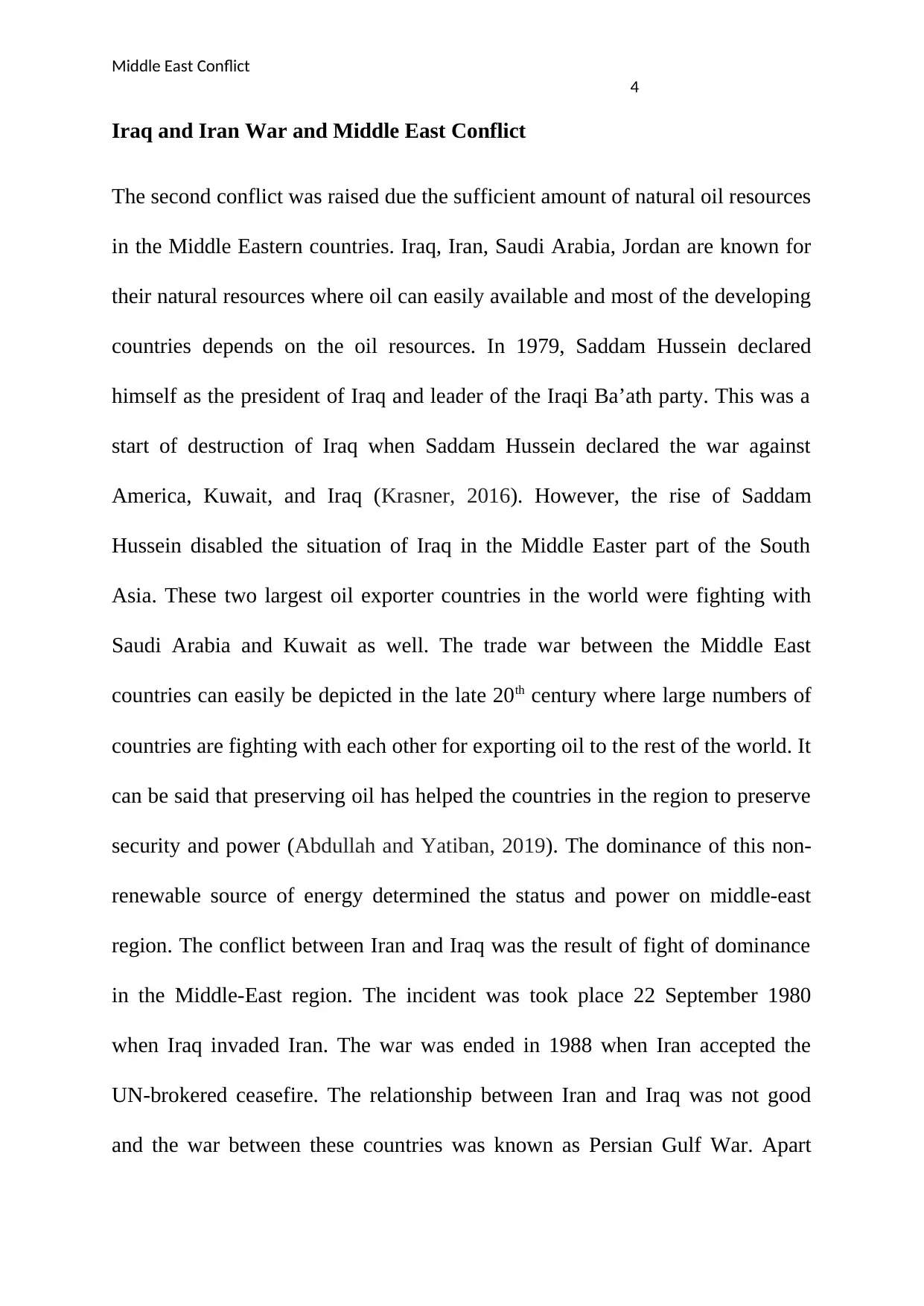
Middle East Conflict
4
Iraq and Iran War and Middle East Conflict
The second conflict was raised due the sufficient amount of natural oil resources
in the Middle Eastern countries. Iraq, Iran, Saudi Arabia, Jordan are known for
their natural resources where oil can easily available and most of the developing
countries depends on the oil resources. In 1979, Saddam Hussein declared
himself as the president of Iraq and leader of the Iraqi Ba’ath party. This was a
start of destruction of Iraq when Saddam Hussein declared the war against
America, Kuwait, and Iraq (Krasner, 2016). However, the rise of Saddam
Hussein disabled the situation of Iraq in the Middle Easter part of the South
Asia. These two largest oil exporter countries in the world were fighting with
Saudi Arabia and Kuwait as well. The trade war between the Middle East
countries can easily be depicted in the late 20th century where large numbers of
countries are fighting with each other for exporting oil to the rest of the world. It
can be said that preserving oil has helped the countries in the region to preserve
security and power (Abdullah and Yatiban, 2019). The dominance of this non-
renewable source of energy determined the status and power on middle-east
region. The conflict between Iran and Iraq was the result of fight of dominance
in the Middle-East region. The incident was took place 22 September 1980
when Iraq invaded Iran. The war was ended in 1988 when Iran accepted the
UN-brokered ceasefire. The relationship between Iran and Iraq was not good
and the war between these countries was known as Persian Gulf War. Apart
4
Iraq and Iran War and Middle East Conflict
The second conflict was raised due the sufficient amount of natural oil resources
in the Middle Eastern countries. Iraq, Iran, Saudi Arabia, Jordan are known for
their natural resources where oil can easily available and most of the developing
countries depends on the oil resources. In 1979, Saddam Hussein declared
himself as the president of Iraq and leader of the Iraqi Ba’ath party. This was a
start of destruction of Iraq when Saddam Hussein declared the war against
America, Kuwait, and Iraq (Krasner, 2016). However, the rise of Saddam
Hussein disabled the situation of Iraq in the Middle Easter part of the South
Asia. These two largest oil exporter countries in the world were fighting with
Saudi Arabia and Kuwait as well. The trade war between the Middle East
countries can easily be depicted in the late 20th century where large numbers of
countries are fighting with each other for exporting oil to the rest of the world. It
can be said that preserving oil has helped the countries in the region to preserve
security and power (Abdullah and Yatiban, 2019). The dominance of this non-
renewable source of energy determined the status and power on middle-east
region. The conflict between Iran and Iraq was the result of fight of dominance
in the Middle-East region. The incident was took place 22 September 1980
when Iraq invaded Iran. The war was ended in 1988 when Iran accepted the
UN-brokered ceasefire. The relationship between Iran and Iraq was not good
and the war between these countries was known as Persian Gulf War. Apart
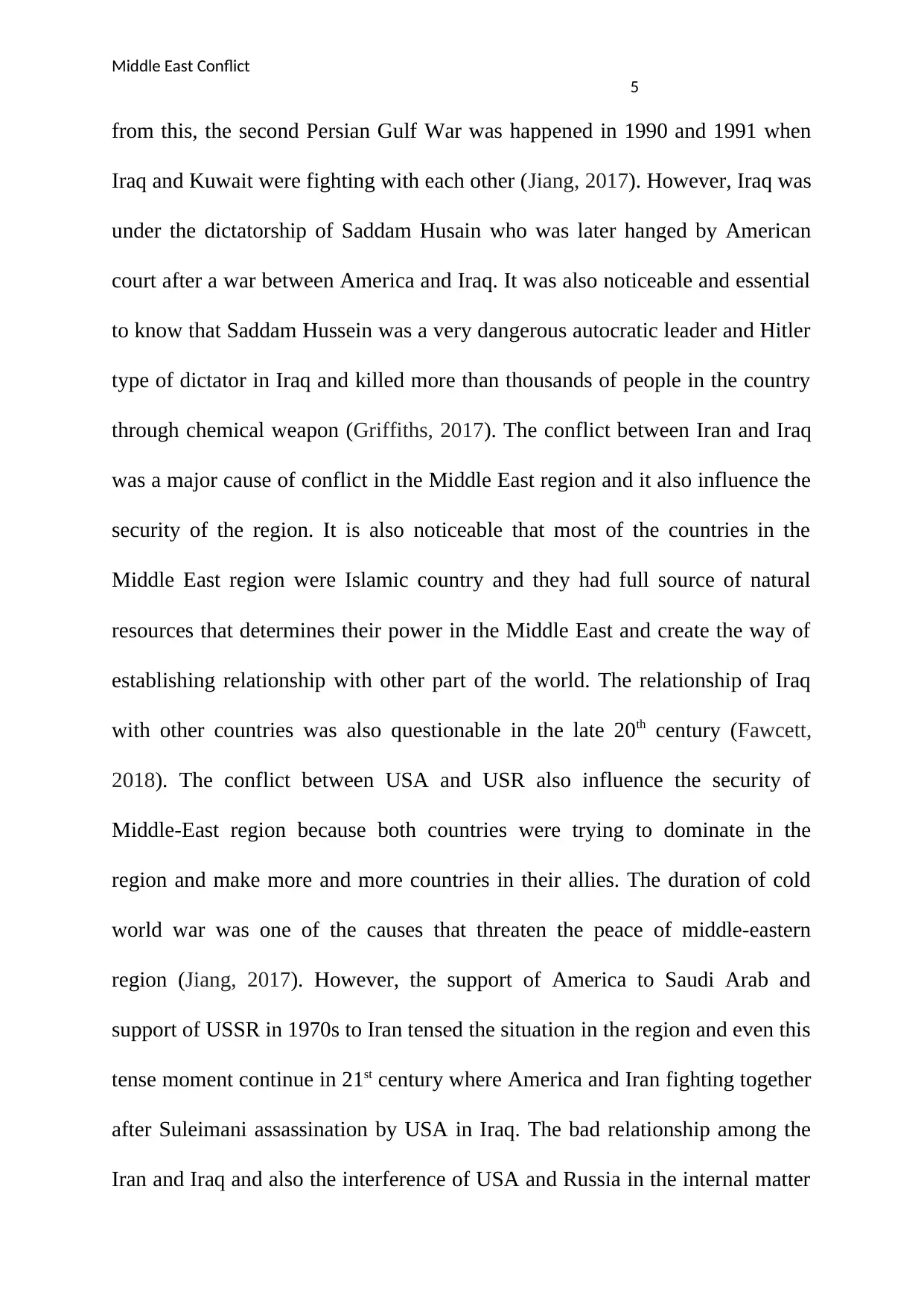
Middle East Conflict
5
from this, the second Persian Gulf War was happened in 1990 and 1991 when
Iraq and Kuwait were fighting with each other (Jiang, 2017). However, Iraq was
under the dictatorship of Saddam Husain who was later hanged by American
court after a war between America and Iraq. It was also noticeable and essential
to know that Saddam Hussein was a very dangerous autocratic leader and Hitler
type of dictator in Iraq and killed more than thousands of people in the country
through chemical weapon (Griffiths, 2017). The conflict between Iran and Iraq
was a major cause of conflict in the Middle East region and it also influence the
security of the region. It is also noticeable that most of the countries in the
Middle East region were Islamic country and they had full source of natural
resources that determines their power in the Middle East and create the way of
establishing relationship with other part of the world. The relationship of Iraq
with other countries was also questionable in the late 20th century (Fawcett,
2018). The conflict between USA and USR also influence the security of
Middle-East region because both countries were trying to dominate in the
region and make more and more countries in their allies. The duration of cold
world war was one of the causes that threaten the peace of middle-eastern
region (Jiang, 2017). However, the support of America to Saudi Arab and
support of USSR in 1970s to Iran tensed the situation in the region and even this
tense moment continue in 21st century where America and Iran fighting together
after Suleimani assassination by USA in Iraq. The bad relationship among the
Iran and Iraq and also the interference of USA and Russia in the internal matter
5
from this, the second Persian Gulf War was happened in 1990 and 1991 when
Iraq and Kuwait were fighting with each other (Jiang, 2017). However, Iraq was
under the dictatorship of Saddam Husain who was later hanged by American
court after a war between America and Iraq. It was also noticeable and essential
to know that Saddam Hussein was a very dangerous autocratic leader and Hitler
type of dictator in Iraq and killed more than thousands of people in the country
through chemical weapon (Griffiths, 2017). The conflict between Iran and Iraq
was a major cause of conflict in the Middle East region and it also influence the
security of the region. It is also noticeable that most of the countries in the
Middle East region were Islamic country and they had full source of natural
resources that determines their power in the Middle East and create the way of
establishing relationship with other part of the world. The relationship of Iraq
with other countries was also questionable in the late 20th century (Fawcett,
2018). The conflict between USA and USR also influence the security of
Middle-East region because both countries were trying to dominate in the
region and make more and more countries in their allies. The duration of cold
world war was one of the causes that threaten the peace of middle-eastern
region (Jiang, 2017). However, the support of America to Saudi Arab and
support of USSR in 1970s to Iran tensed the situation in the region and even this
tense moment continue in 21st century where America and Iran fighting together
after Suleimani assassination by USA in Iraq. The bad relationship among the
Iran and Iraq and also the interference of USA and Russia in the internal matter
⊘ This is a preview!⊘
Do you want full access?
Subscribe today to unlock all pages.

Trusted by 1+ million students worldwide
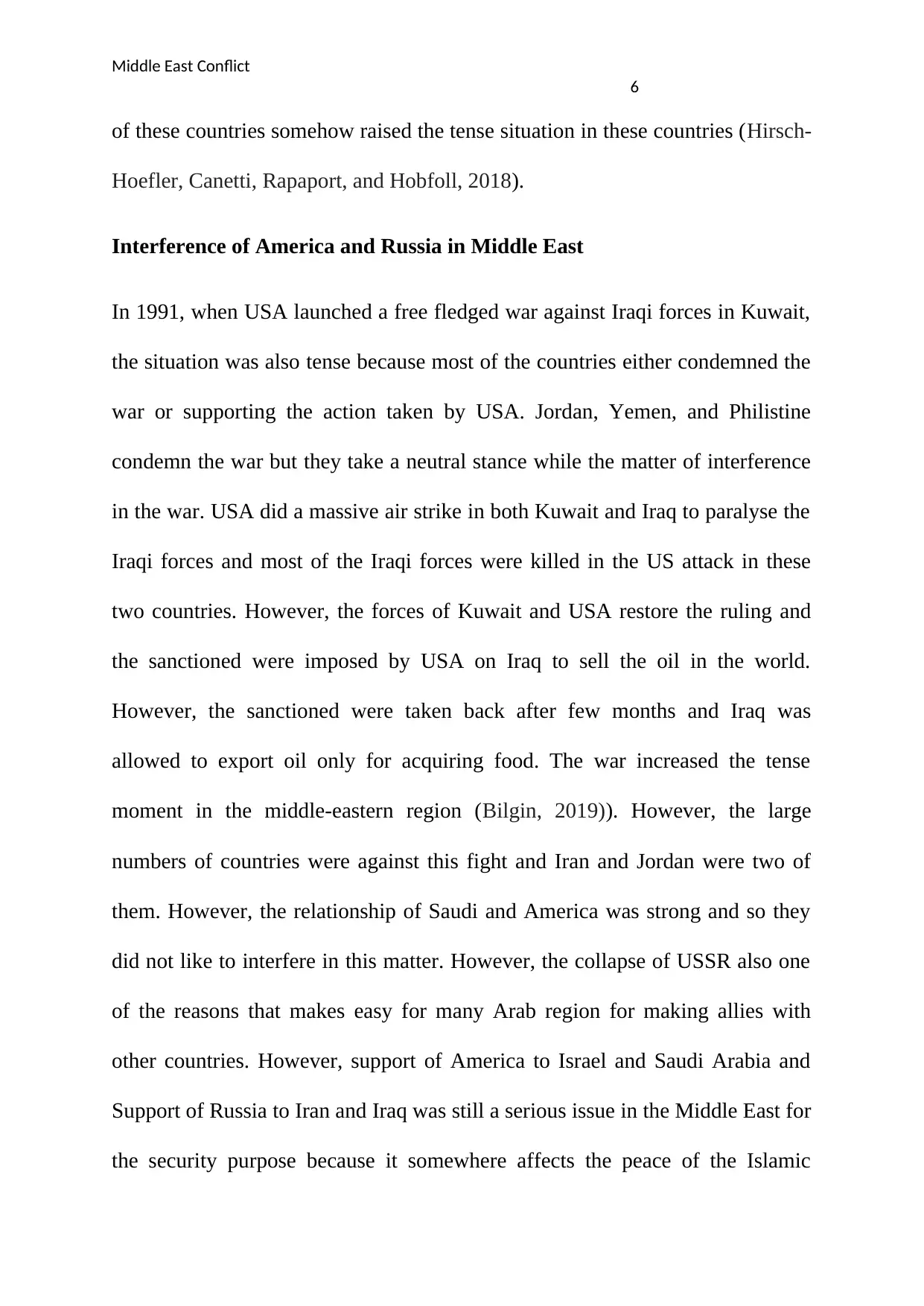
Middle East Conflict
6
of these countries somehow raised the tense situation in these countries (Hirsch-
Hoefler, Canetti, Rapaport, and Hobfoll, 2018).
Interference of America and Russia in Middle East
In 1991, when USA launched a free fledged war against Iraqi forces in Kuwait,
the situation was also tense because most of the countries either condemned the
war or supporting the action taken by USA. Jordan, Yemen, and Philistine
condemn the war but they take a neutral stance while the matter of interference
in the war. USA did a massive air strike in both Kuwait and Iraq to paralyse the
Iraqi forces and most of the Iraqi forces were killed in the US attack in these
two countries. However, the forces of Kuwait and USA restore the ruling and
the sanctioned were imposed by USA on Iraq to sell the oil in the world.
However, the sanctioned were taken back after few months and Iraq was
allowed to export oil only for acquiring food. The war increased the tense
moment in the middle-eastern region (Bilgin, 2019)). However, the large
numbers of countries were against this fight and Iran and Jordan were two of
them. However, the relationship of Saudi and America was strong and so they
did not like to interfere in this matter. However, the collapse of USSR also one
of the reasons that makes easy for many Arab region for making allies with
other countries. However, support of America to Israel and Saudi Arabia and
Support of Russia to Iran and Iraq was still a serious issue in the Middle East for
the security purpose because it somewhere affects the peace of the Islamic
6
of these countries somehow raised the tense situation in these countries (Hirsch-
Hoefler, Canetti, Rapaport, and Hobfoll, 2018).
Interference of America and Russia in Middle East
In 1991, when USA launched a free fledged war against Iraqi forces in Kuwait,
the situation was also tense because most of the countries either condemned the
war or supporting the action taken by USA. Jordan, Yemen, and Philistine
condemn the war but they take a neutral stance while the matter of interference
in the war. USA did a massive air strike in both Kuwait and Iraq to paralyse the
Iraqi forces and most of the Iraqi forces were killed in the US attack in these
two countries. However, the forces of Kuwait and USA restore the ruling and
the sanctioned were imposed by USA on Iraq to sell the oil in the world.
However, the sanctioned were taken back after few months and Iraq was
allowed to export oil only for acquiring food. The war increased the tense
moment in the middle-eastern region (Bilgin, 2019)). However, the large
numbers of countries were against this fight and Iran and Jordan were two of
them. However, the relationship of Saudi and America was strong and so they
did not like to interfere in this matter. However, the collapse of USSR also one
of the reasons that makes easy for many Arab region for making allies with
other countries. However, support of America to Israel and Saudi Arabia and
Support of Russia to Iran and Iraq was still a serious issue in the Middle East for
the security purpose because it somewhere affects the peace of the Islamic
Paraphrase This Document
Need a fresh take? Get an instant paraphrase of this document with our AI Paraphraser
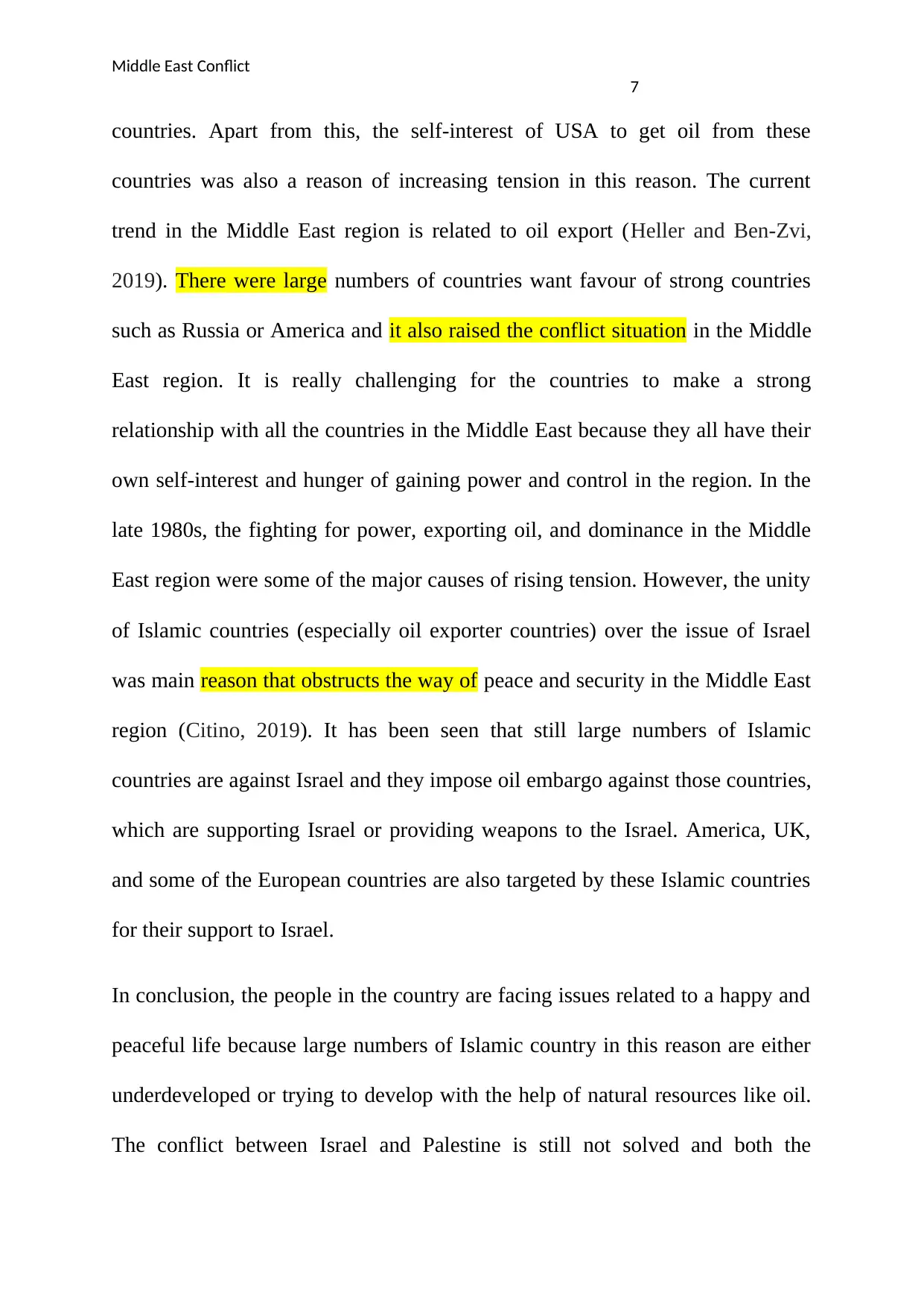
Middle East Conflict
7
countries. Apart from this, the self-interest of USA to get oil from these
countries was also a reason of increasing tension in this reason. The current
trend in the Middle East region is related to oil export (Heller and Ben-Zvi,
2019). There were large numbers of countries want favour of strong countries
such as Russia or America and it also raised the conflict situation in the Middle
East region. It is really challenging for the countries to make a strong
relationship with all the countries in the Middle East because they all have their
own self-interest and hunger of gaining power and control in the region. In the
late 1980s, the fighting for power, exporting oil, and dominance in the Middle
East region were some of the major causes of rising tension. However, the unity
of Islamic countries (especially oil exporter countries) over the issue of Israel
was main reason that obstructs the way of peace and security in the Middle East
region (Citino, 2019). It has been seen that still large numbers of Islamic
countries are against Israel and they impose oil embargo against those countries,
which are supporting Israel or providing weapons to the Israel. America, UK,
and some of the European countries are also targeted by these Islamic countries
for their support to Israel.
In conclusion, the people in the country are facing issues related to a happy and
peaceful life because large numbers of Islamic country in this reason are either
underdeveloped or trying to develop with the help of natural resources like oil.
The conflict between Israel and Palestine is still not solved and both the
7
countries. Apart from this, the self-interest of USA to get oil from these
countries was also a reason of increasing tension in this reason. The current
trend in the Middle East region is related to oil export (Heller and Ben-Zvi,
2019). There were large numbers of countries want favour of strong countries
such as Russia or America and it also raised the conflict situation in the Middle
East region. It is really challenging for the countries to make a strong
relationship with all the countries in the Middle East because they all have their
own self-interest and hunger of gaining power and control in the region. In the
late 1980s, the fighting for power, exporting oil, and dominance in the Middle
East region were some of the major causes of rising tension. However, the unity
of Islamic countries (especially oil exporter countries) over the issue of Israel
was main reason that obstructs the way of peace and security in the Middle East
region (Citino, 2019). It has been seen that still large numbers of Islamic
countries are against Israel and they impose oil embargo against those countries,
which are supporting Israel or providing weapons to the Israel. America, UK,
and some of the European countries are also targeted by these Islamic countries
for their support to Israel.
In conclusion, the people in the country are facing issues related to a happy and
peaceful life because large numbers of Islamic country in this reason are either
underdeveloped or trying to develop with the help of natural resources like oil.
The conflict between Israel and Palestine is still not solved and both the
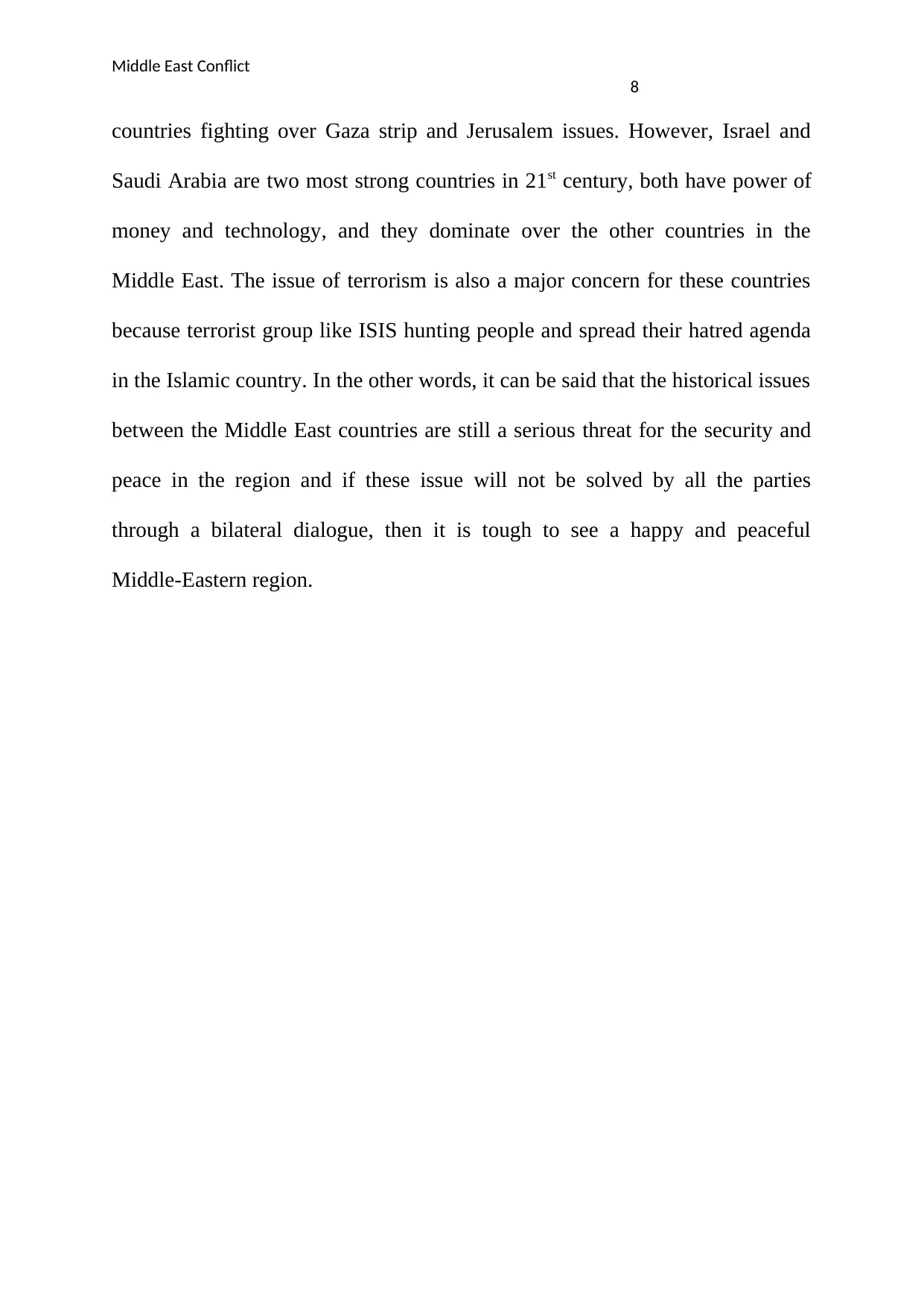
Middle East Conflict
8
countries fighting over Gaza strip and Jerusalem issues. However, Israel and
Saudi Arabia are two most strong countries in 21st century, both have power of
money and technology, and they dominate over the other countries in the
Middle East. The issue of terrorism is also a major concern for these countries
because terrorist group like ISIS hunting people and spread their hatred agenda
in the Islamic country. In the other words, it can be said that the historical issues
between the Middle East countries are still a serious threat for the security and
peace in the region and if these issue will not be solved by all the parties
through a bilateral dialogue, then it is tough to see a happy and peaceful
Middle-Eastern region.
8
countries fighting over Gaza strip and Jerusalem issues. However, Israel and
Saudi Arabia are two most strong countries in 21st century, both have power of
money and technology, and they dominate over the other countries in the
Middle East. The issue of terrorism is also a major concern for these countries
because terrorist group like ISIS hunting people and spread their hatred agenda
in the Islamic country. In the other words, it can be said that the historical issues
between the Middle East countries are still a serious threat for the security and
peace in the region and if these issue will not be solved by all the parties
through a bilateral dialogue, then it is tough to see a happy and peaceful
Middle-Eastern region.
⊘ This is a preview!⊘
Do you want full access?
Subscribe today to unlock all pages.

Trusted by 1+ million students worldwide
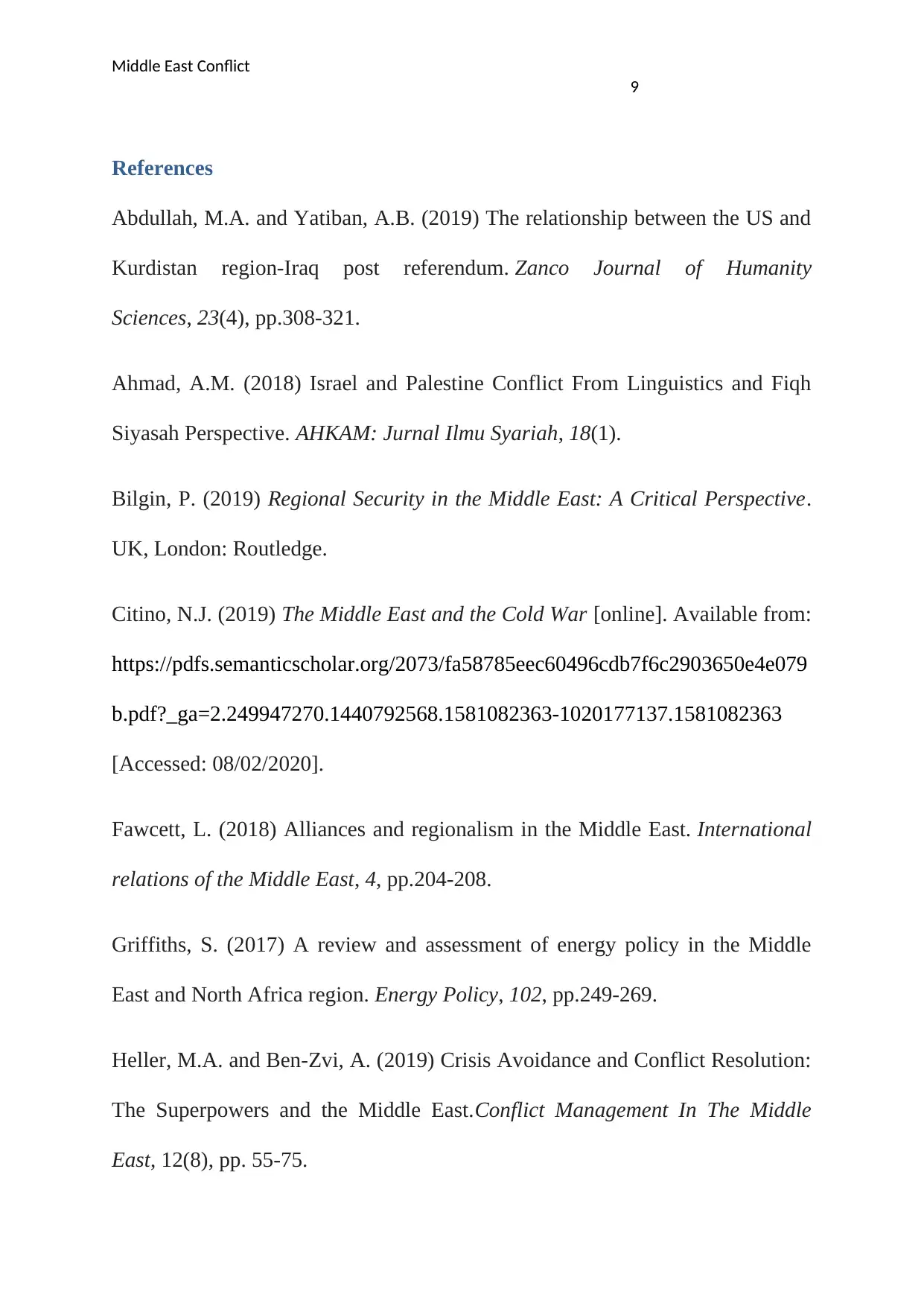
Middle East Conflict
9
References
Abdullah, M.A. and Yatiban, A.B. (2019) The relationship between the US and
Kurdistan region-Iraq post referendum. Zanco Journal of Humanity
Sciences, 23(4), pp.308-321.
Ahmad, A.M. (2018) Israel and Palestine Conflict From Linguistics and Fiqh
Siyasah Perspective. AHKAM: Jurnal Ilmu Syariah, 18(1).
Bilgin, P. (2019) Regional Security in the Middle East: A Critical Perspective.
UK, London: Routledge.
Citino, N.J. (2019) The Middle East and the Cold War [online]. Available from:
https://pdfs.semanticscholar.org/2073/fa58785eec60496cdb7f6c2903650e4e079
b.pdf?_ga=2.249947270.1440792568.1581082363-1020177137.1581082363
[Accessed: 08/02/2020].
Fawcett, L. (2018) Alliances and regionalism in the Middle East. International
relations of the Middle East, 4, pp.204-208.
Griffiths, S. (2017) A review and assessment of energy policy in the Middle
East and North Africa region. Energy Policy, 102, pp.249-269.
Heller, M.A. and Ben-Zvi, A. (2019) Crisis Avoidance and Conflict Resolution:
The Superpowers and the Middle East.Conflict Management In The Middle
East, 12(8), pp. 55-75.
9
References
Abdullah, M.A. and Yatiban, A.B. (2019) The relationship between the US and
Kurdistan region-Iraq post referendum. Zanco Journal of Humanity
Sciences, 23(4), pp.308-321.
Ahmad, A.M. (2018) Israel and Palestine Conflict From Linguistics and Fiqh
Siyasah Perspective. AHKAM: Jurnal Ilmu Syariah, 18(1).
Bilgin, P. (2019) Regional Security in the Middle East: A Critical Perspective.
UK, London: Routledge.
Citino, N.J. (2019) The Middle East and the Cold War [online]. Available from:
https://pdfs.semanticscholar.org/2073/fa58785eec60496cdb7f6c2903650e4e079
b.pdf?_ga=2.249947270.1440792568.1581082363-1020177137.1581082363
[Accessed: 08/02/2020].
Fawcett, L. (2018) Alliances and regionalism in the Middle East. International
relations of the Middle East, 4, pp.204-208.
Griffiths, S. (2017) A review and assessment of energy policy in the Middle
East and North Africa region. Energy Policy, 102, pp.249-269.
Heller, M.A. and Ben-Zvi, A. (2019) Crisis Avoidance and Conflict Resolution:
The Superpowers and the Middle East.Conflict Management In The Middle
East, 12(8), pp. 55-75.
Paraphrase This Document
Need a fresh take? Get an instant paraphrase of this document with our AI Paraphraser
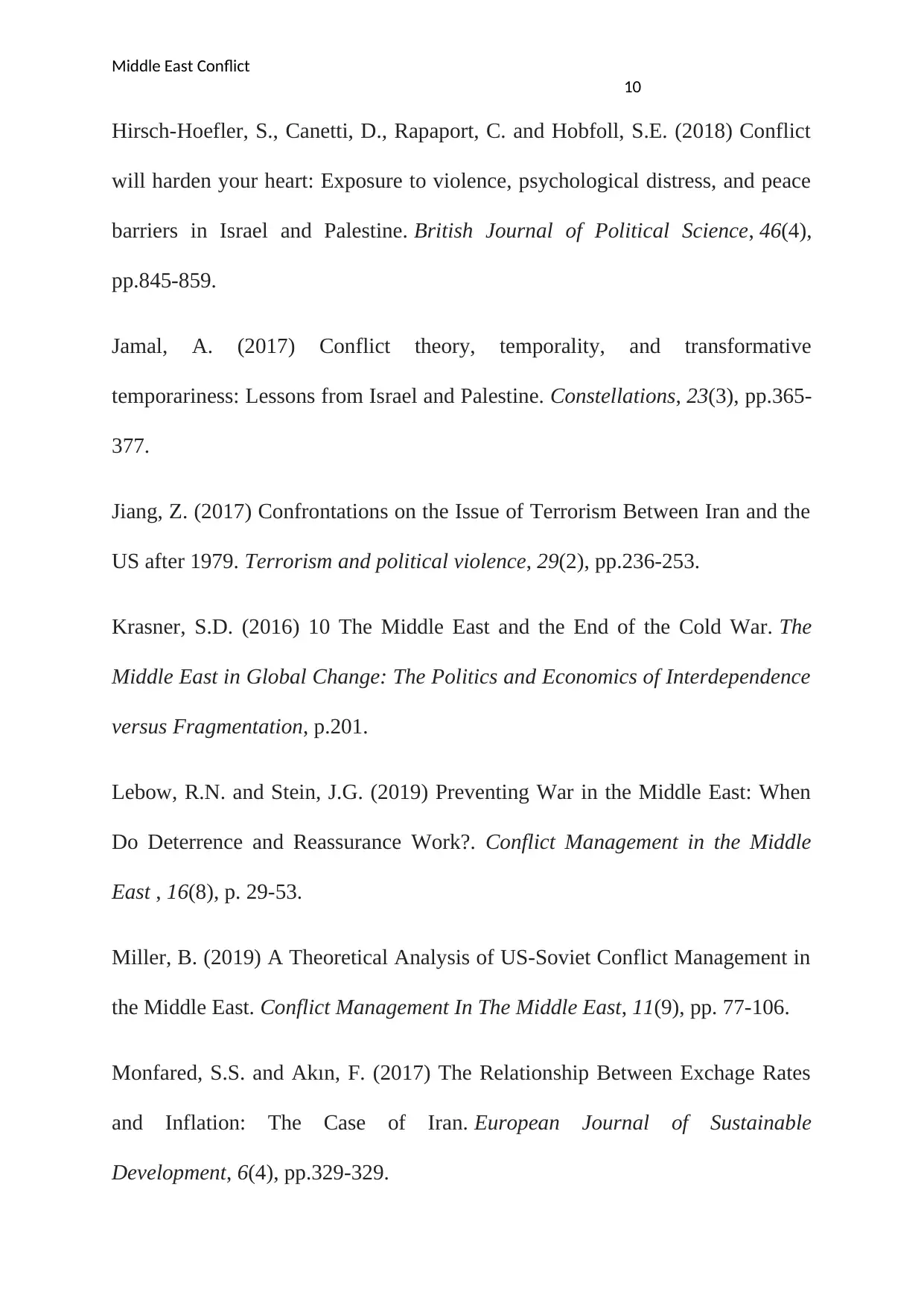
Middle East Conflict
10
Hirsch-Hoefler, S., Canetti, D., Rapaport, C. and Hobfoll, S.E. (2018) Conflict
will harden your heart: Exposure to violence, psychological distress, and peace
barriers in Israel and Palestine. British Journal of Political Science, 46(4),
pp.845-859.
Jamal, A. (2017) Conflict theory, temporality, and transformative
temporariness: Lessons from Israel and Palestine. Constellations, 23(3), pp.365-
377.
Jiang, Z. (2017) Confrontations on the Issue of Terrorism Between Iran and the
US after 1979. Terrorism and political violence, 29(2), pp.236-253.
Krasner, S.D. (2016) 10 The Middle East and the End of the Cold War. The
Middle East in Global Change: The Politics and Economics of Interdependence
versus Fragmentation, p.201.
Lebow, R.N. and Stein, J.G. (2019) Preventing War in the Middle East: When
Do Deterrence and Reassurance Work?. Conflict Management in the Middle
East , 16(8), p. 29-53.
Miller, B. (2019) A Theoretical Analysis of US-Soviet Conflict Management in
the Middle East. Conflict Management In The Middle East, 11(9), pp. 77-106.
Monfared, S.S. and Akın, F. (2017) The Relationship Between Exchage Rates
and Inflation: The Case of Iran. European Journal of Sustainable
Development, 6(4), pp.329-329.
10
Hirsch-Hoefler, S., Canetti, D., Rapaport, C. and Hobfoll, S.E. (2018) Conflict
will harden your heart: Exposure to violence, psychological distress, and peace
barriers in Israel and Palestine. British Journal of Political Science, 46(4),
pp.845-859.
Jamal, A. (2017) Conflict theory, temporality, and transformative
temporariness: Lessons from Israel and Palestine. Constellations, 23(3), pp.365-
377.
Jiang, Z. (2017) Confrontations on the Issue of Terrorism Between Iran and the
US after 1979. Terrorism and political violence, 29(2), pp.236-253.
Krasner, S.D. (2016) 10 The Middle East and the End of the Cold War. The
Middle East in Global Change: The Politics and Economics of Interdependence
versus Fragmentation, p.201.
Lebow, R.N. and Stein, J.G. (2019) Preventing War in the Middle East: When
Do Deterrence and Reassurance Work?. Conflict Management in the Middle
East , 16(8), p. 29-53.
Miller, B. (2019) A Theoretical Analysis of US-Soviet Conflict Management in
the Middle East. Conflict Management In The Middle East, 11(9), pp. 77-106.
Monfared, S.S. and Akın, F. (2017) The Relationship Between Exchage Rates
and Inflation: The Case of Iran. European Journal of Sustainable
Development, 6(4), pp.329-329.

Middle East Conflict
11
Rehman, N., Shah, S.I.A., Ali, A., Jang, S.Y. and Park, C. (2018) Another View
on the Middle East Conflict Analysis. Applied Sciences, 8(9), p.1545.
11
Rehman, N., Shah, S.I.A., Ali, A., Jang, S.Y. and Park, C. (2018) Another View
on the Middle East Conflict Analysis. Applied Sciences, 8(9), p.1545.
⊘ This is a preview!⊘
Do you want full access?
Subscribe today to unlock all pages.

Trusted by 1+ million students worldwide
1 out of 12
Your All-in-One AI-Powered Toolkit for Academic Success.
+13062052269
info@desklib.com
Available 24*7 on WhatsApp / Email
![[object Object]](/_next/static/media/star-bottom.7253800d.svg)
Unlock your academic potential
Copyright © 2020–2025 A2Z Services. All Rights Reserved. Developed and managed by ZUCOL.


